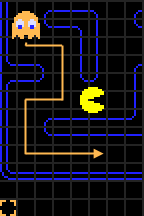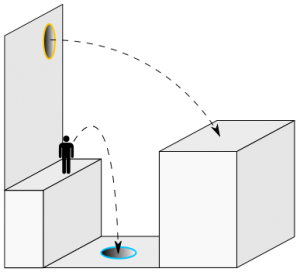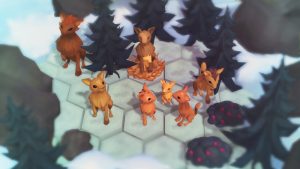Implicit Tutorials (Notes from Indie Game Show & Tell)
Posted on Tue 20 June 2017 in Gamedev
When I discussed educational games, I omitted one very common type: games that teach you how to play the game itself.
Last week I participated in the Indie Game Show & Tell in Amsterdam. And there I learned about self-explanatory games, and also the fact that Happy Usagi currently sucks at this.
The idea is also called "Implicit tutorials", and is an important concept in game design. There should be no need for a manual (nobody reads it anyway). The less explanation, the better. By gradually introducing game elements in a clever way, the game should just explain itself . Super Mario World 1-1 is a very famous example of this.
The first demo of the evening was by Jeroen Wimmers about the game "Circles" (See the screenshot above). It really drove home the point of implicit tutorials. Circles is what you may call an example of "Constraint-based game design", the constraint being that everything, every single thing, is a circle. Start of the level: a circle. Goal of the level: a circle. Level select menu - a bunch of circles. In a relentless drive to eliminate shapes with corners, explanatory text has no place. How does the player know that you're not supposed to touch certain circles? Jeroen showed how he went through dozens of iterations, trying different visual cues (trembling, disappearing, expanding), keeping this and reverting that, until the game was crystal clear. Circles is out on steam if you want to give it a try. (There is a free demo).
Another talk on a very similar topic was about Reggie, by Degoma games. Reggie is a tomato with the ability to reverse gravity, in a cool little platformer. This game similarly went through several design iterations, incorporating feedback from players at conventions, until finally the mechanics were universally understood. You can watch the entire talk on Youtube:
But there is a downside to implicit tutorials. A tutorial can slow down the pace and make players give up before they get to the good parts. I can think of a few recent games that suffer from this.
I myself was there to present Happy Usagi. There is no recording of the talk. But I showed this movie which is also on Youtube:
While showing this video I explained that the game has an "altitude-bonus" mechanic. It works as follows. When your bunnies are happy and well-fed, they jump more. For each jump, you get points. The points are multiplied by how high the bunny is. For a jump at floor level, you get 10 points. A jump on a stack of four blocks tall rewards you with 40 points. This mechanic encourages you to build. By building higher, you make each jump worth more.
The audience asked me this insightful question: "How does the player find out about this mechanic?" After all, how can a reward incentivise players to do something, if they don't know that there is a reward? The truth is that this is an area where the game can be much improved. I did add a small hint: When a bunny jumps, a number appears at that spot to indicate that points were scored. But it's very easy to miss the connection between score and altitude. To a casual observer, it seems the score is calculated pretty much at random. Here the player needs explicit explanation.
So that is some very useful feedback. And that's what made this event so great - not only to have the chance to present our work, but also to get feedback from fellow game designers, and to learn more about game design.


